Management Accounting Report: Systems, Costing, and Planning
VerifiedAdded on 2023/01/19
|18
|5305
|54
Report
AI Summary
This report delves into the realm of management accounting, focusing on various systems and methods used for internal financial analysis and decision-making within a manufacturing context. It explores different management accounting systems like cost accounting, inventory management, job costing, and price optimization systems, highlighting their merits and applications. The report further examines diverse management accounting reporting methods, including budget reports, cost reports, execution reports, inventory reports, manufacturing reports, job costing reports, performance reports, and accounts receivable reports, explaining their roles in providing insights for managerial decision-making. Additionally, the report provides a practical demonstration of cost calculation using marginal and absorption costing methods, offering a comparative analysis. The report also outlines different planning tools, discussing their benefits and drawbacks, and illustrates how management accounting techniques can aid in resolving financial problems, providing a comprehensive overview of the subject.
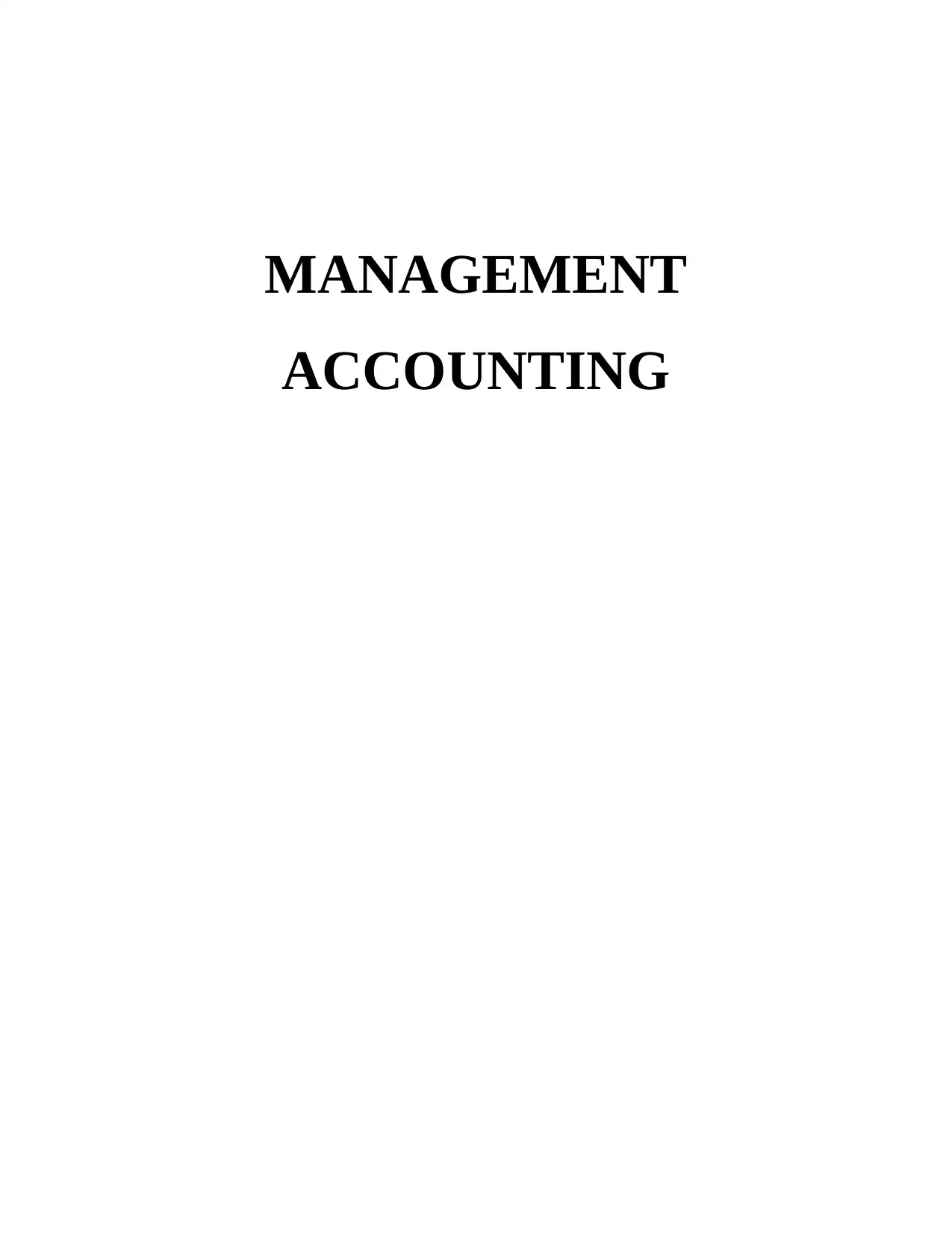
MANAGEMENT
ACCOUNTING
ACCOUNTING
Paraphrase This Document
Need a fresh take? Get an instant paraphrase of this document with our AI Paraphraser
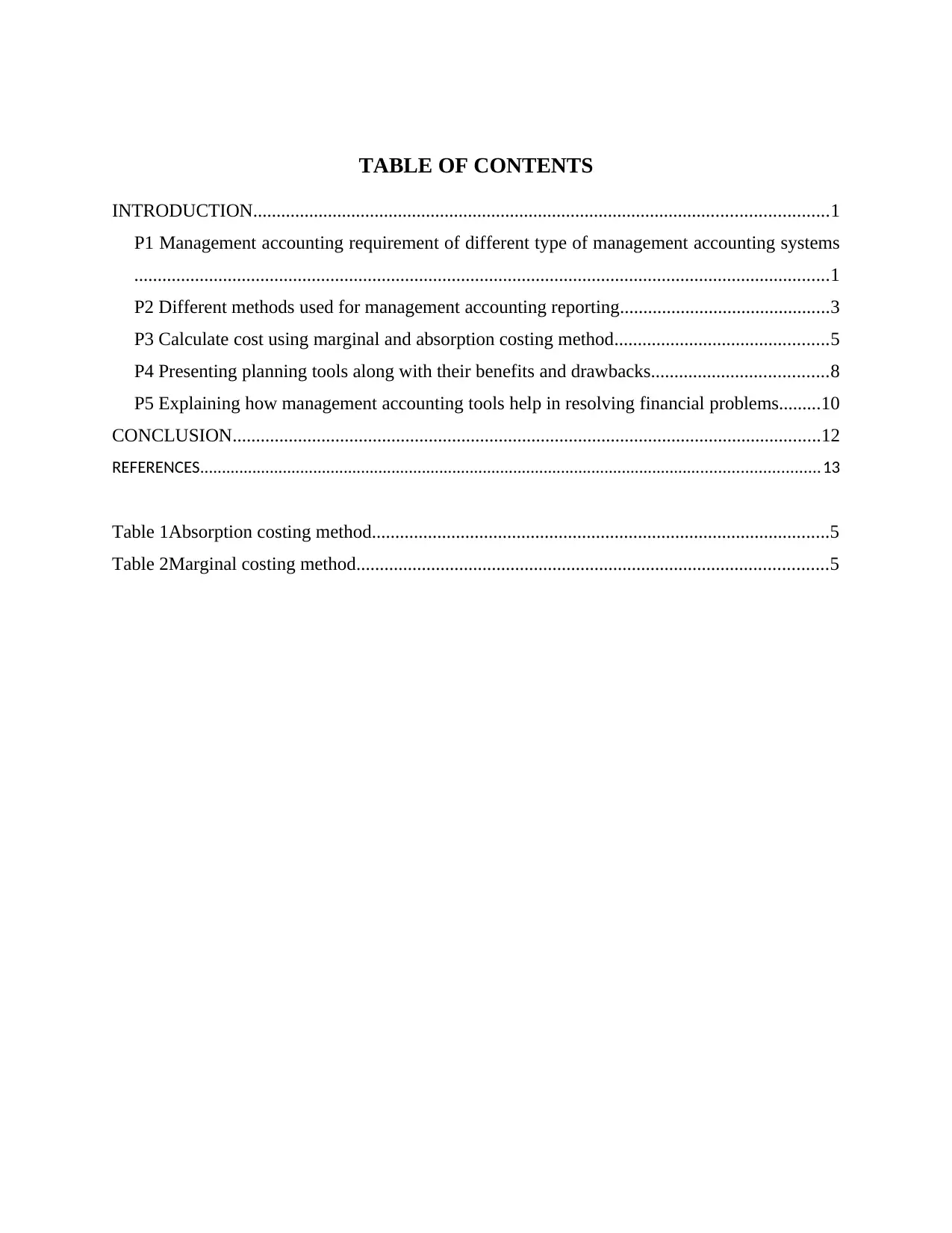
TABLE OF CONTENTS
INTRODUCTION...........................................................................................................................1
P1 Management accounting requirement of different type of management accounting systems
.....................................................................................................................................................1
P2 Different methods used for management accounting reporting.............................................3
P3 Calculate cost using marginal and absorption costing method..............................................5
P4 Presenting planning tools along with their benefits and drawbacks......................................8
P5 Explaining how management accounting tools help in resolving financial problems.........10
CONCLUSION..............................................................................................................................12
REFERENCES..............................................................................................................................................13
Table 1Absorption costing method..................................................................................................5
Table 2Marginal costing method.....................................................................................................5
INTRODUCTION...........................................................................................................................1
P1 Management accounting requirement of different type of management accounting systems
.....................................................................................................................................................1
P2 Different methods used for management accounting reporting.............................................3
P3 Calculate cost using marginal and absorption costing method..............................................5
P4 Presenting planning tools along with their benefits and drawbacks......................................8
P5 Explaining how management accounting tools help in resolving financial problems.........10
CONCLUSION..............................................................................................................................12
REFERENCES..............................................................................................................................................13
Table 1Absorption costing method..................................................................................................5
Table 2Marginal costing method.....................................................................................................5
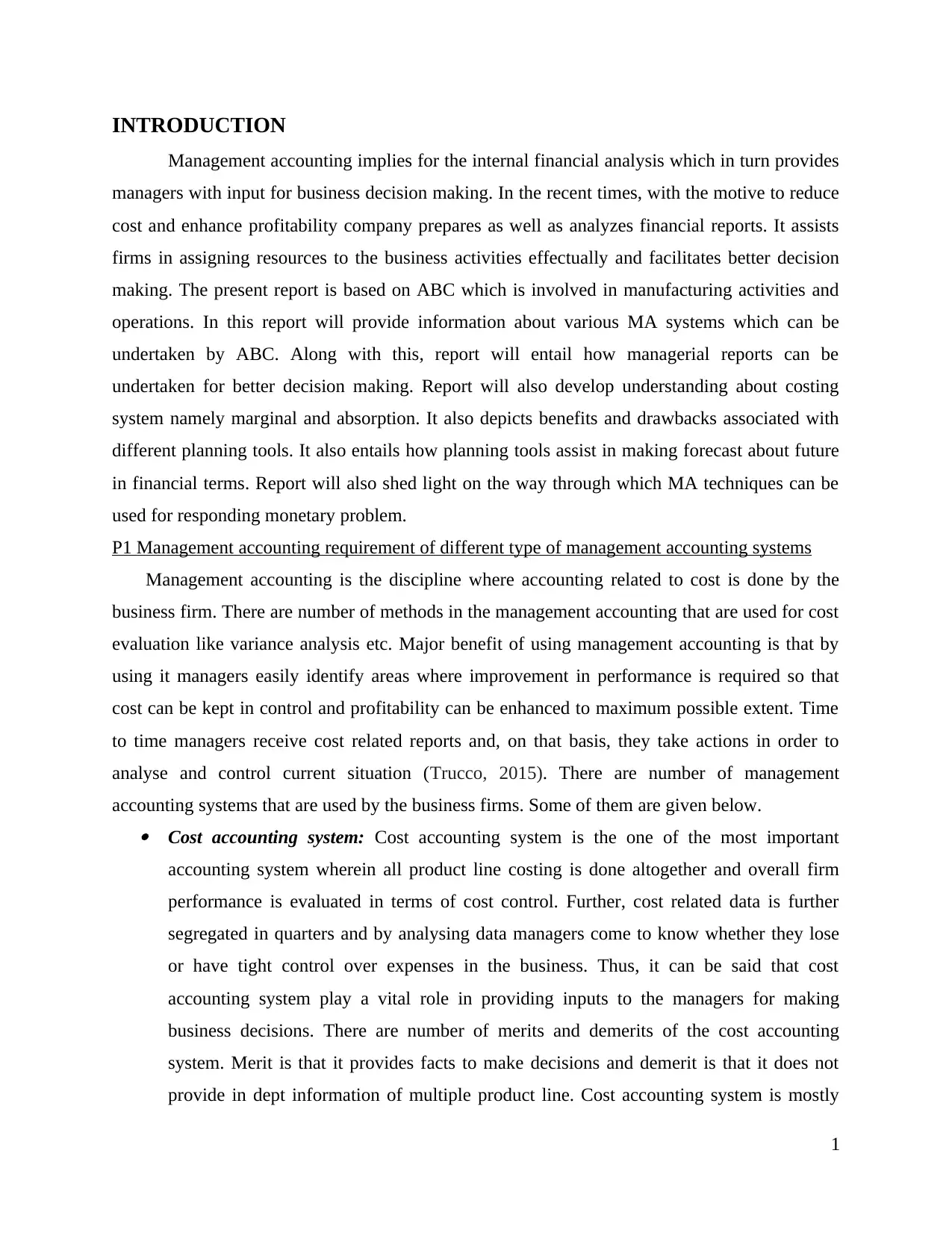
INTRODUCTION
Management accounting implies for the internal financial analysis which in turn provides
managers with input for business decision making. In the recent times, with the motive to reduce
cost and enhance profitability company prepares as well as analyzes financial reports. It assists
firms in assigning resources to the business activities effectually and facilitates better decision
making. The present report is based on ABC which is involved in manufacturing activities and
operations. In this report will provide information about various MA systems which can be
undertaken by ABC. Along with this, report will entail how managerial reports can be
undertaken for better decision making. Report will also develop understanding about costing
system namely marginal and absorption. It also depicts benefits and drawbacks associated with
different planning tools. It also entails how planning tools assist in making forecast about future
in financial terms. Report will also shed light on the way through which MA techniques can be
used for responding monetary problem.
P1 Management accounting requirement of different type of management accounting systems
Management accounting is the discipline where accounting related to cost is done by the
business firm. There are number of methods in the management accounting that are used for cost
evaluation like variance analysis etc. Major benefit of using management accounting is that by
using it managers easily identify areas where improvement in performance is required so that
cost can be kept in control and profitability can be enhanced to maximum possible extent. Time
to time managers receive cost related reports and, on that basis, they take actions in order to
analyse and control current situation (Trucco, 2015). There are number of management
accounting systems that are used by the business firms. Some of them are given below. Cost accounting system: Cost accounting system is the one of the most important
accounting system wherein all product line costing is done altogether and overall firm
performance is evaluated in terms of cost control. Further, cost related data is further
segregated in quarters and by analysing data managers come to know whether they lose
or have tight control over expenses in the business. Thus, it can be said that cost
accounting system play a vital role in providing inputs to the managers for making
business decisions. There are number of merits and demerits of the cost accounting
system. Merit is that it provides facts to make decisions and demerit is that it does not
provide in dept information of multiple product line. Cost accounting system is mostly
1
Management accounting implies for the internal financial analysis which in turn provides
managers with input for business decision making. In the recent times, with the motive to reduce
cost and enhance profitability company prepares as well as analyzes financial reports. It assists
firms in assigning resources to the business activities effectually and facilitates better decision
making. The present report is based on ABC which is involved in manufacturing activities and
operations. In this report will provide information about various MA systems which can be
undertaken by ABC. Along with this, report will entail how managerial reports can be
undertaken for better decision making. Report will also develop understanding about costing
system namely marginal and absorption. It also depicts benefits and drawbacks associated with
different planning tools. It also entails how planning tools assist in making forecast about future
in financial terms. Report will also shed light on the way through which MA techniques can be
used for responding monetary problem.
P1 Management accounting requirement of different type of management accounting systems
Management accounting is the discipline where accounting related to cost is done by the
business firm. There are number of methods in the management accounting that are used for cost
evaluation like variance analysis etc. Major benefit of using management accounting is that by
using it managers easily identify areas where improvement in performance is required so that
cost can be kept in control and profitability can be enhanced to maximum possible extent. Time
to time managers receive cost related reports and, on that basis, they take actions in order to
analyse and control current situation (Trucco, 2015). There are number of management
accounting systems that are used by the business firms. Some of them are given below. Cost accounting system: Cost accounting system is the one of the most important
accounting system wherein all product line costing is done altogether and overall firm
performance is evaluated in terms of cost control. Further, cost related data is further
segregated in quarters and by analysing data managers come to know whether they lose
or have tight control over expenses in the business. Thus, it can be said that cost
accounting system play a vital role in providing inputs to the managers for making
business decisions. There are number of merits and demerits of the cost accounting
system. Merit is that it provides facts to make decisions and demerit is that it does not
provide in dept information of multiple product line. Cost accounting system is mostly
1
⊘ This is a preview!⊘
Do you want full access?
Subscribe today to unlock all pages.

Trusted by 1+ million students worldwide
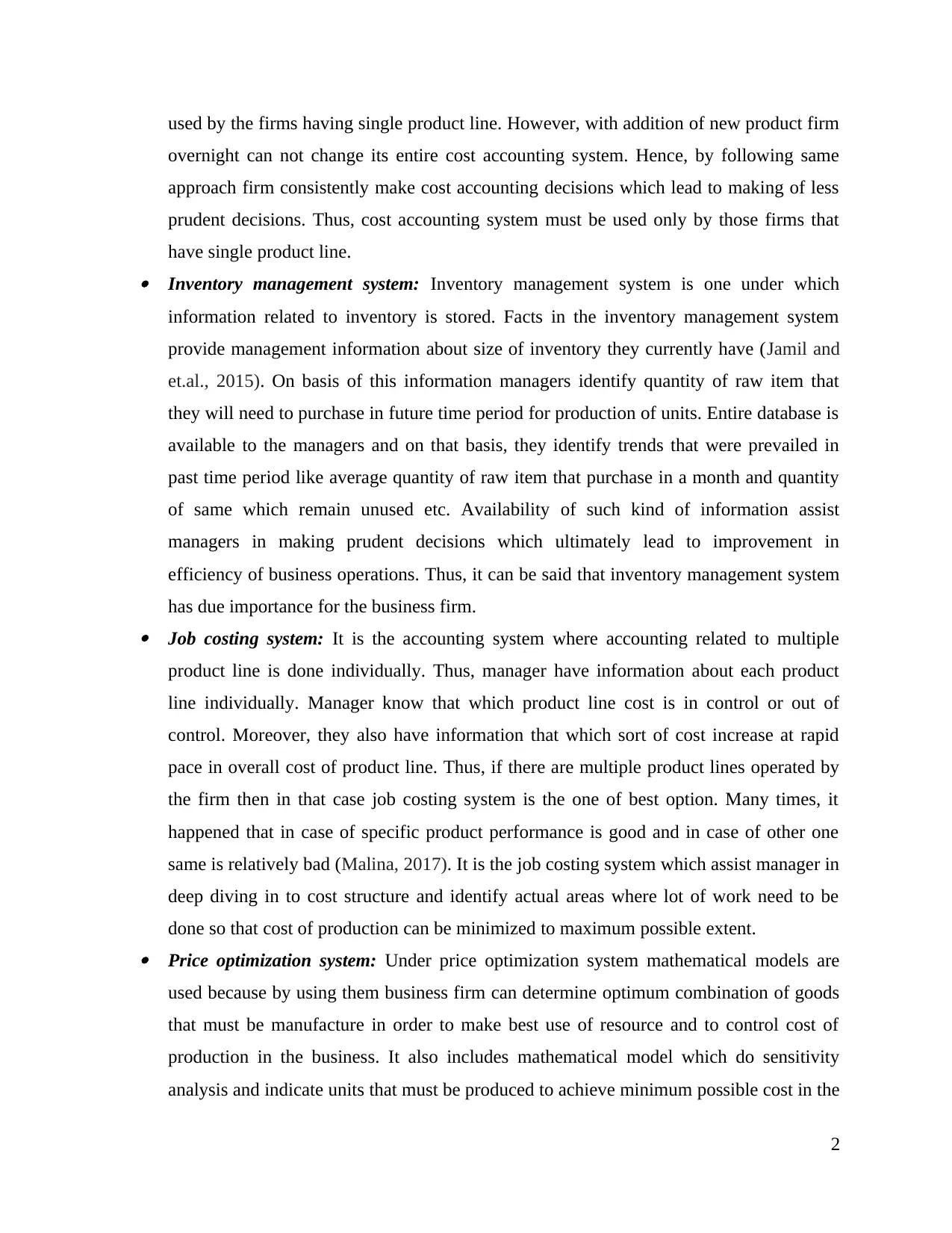
used by the firms having single product line. However, with addition of new product firm
overnight can not change its entire cost accounting system. Hence, by following same
approach firm consistently make cost accounting decisions which lead to making of less
prudent decisions. Thus, cost accounting system must be used only by those firms that
have single product line. Inventory management system: Inventory management system is one under which
information related to inventory is stored. Facts in the inventory management system
provide management information about size of inventory they currently have (Jamil and
et.al., 2015). On basis of this information managers identify quantity of raw item that
they will need to purchase in future time period for production of units. Entire database is
available to the managers and on that basis, they identify trends that were prevailed in
past time period like average quantity of raw item that purchase in a month and quantity
of same which remain unused etc. Availability of such kind of information assist
managers in making prudent decisions which ultimately lead to improvement in
efficiency of business operations. Thus, it can be said that inventory management system
has due importance for the business firm. Job costing system: It is the accounting system where accounting related to multiple
product line is done individually. Thus, manager have information about each product
line individually. Manager know that which product line cost is in control or out of
control. Moreover, they also have information that which sort of cost increase at rapid
pace in overall cost of product line. Thus, if there are multiple product lines operated by
the firm then in that case job costing system is the one of best option. Many times, it
happened that in case of specific product performance is good and in case of other one
same is relatively bad (Malina, 2017). It is the job costing system which assist manager in
deep diving in to cost structure and identify actual areas where lot of work need to be
done so that cost of production can be minimized to maximum possible extent. Price optimization system: Under price optimization system mathematical models are
used because by using them business firm can determine optimum combination of goods
that must be manufacture in order to make best use of resource and to control cost of
production in the business. It also includes mathematical model which do sensitivity
analysis and indicate units that must be produced to achieve minimum possible cost in the
2
overnight can not change its entire cost accounting system. Hence, by following same
approach firm consistently make cost accounting decisions which lead to making of less
prudent decisions. Thus, cost accounting system must be used only by those firms that
have single product line. Inventory management system: Inventory management system is one under which
information related to inventory is stored. Facts in the inventory management system
provide management information about size of inventory they currently have (Jamil and
et.al., 2015). On basis of this information managers identify quantity of raw item that
they will need to purchase in future time period for production of units. Entire database is
available to the managers and on that basis, they identify trends that were prevailed in
past time period like average quantity of raw item that purchase in a month and quantity
of same which remain unused etc. Availability of such kind of information assist
managers in making prudent decisions which ultimately lead to improvement in
efficiency of business operations. Thus, it can be said that inventory management system
has due importance for the business firm. Job costing system: It is the accounting system where accounting related to multiple
product line is done individually. Thus, manager have information about each product
line individually. Manager know that which product line cost is in control or out of
control. Moreover, they also have information that which sort of cost increase at rapid
pace in overall cost of product line. Thus, if there are multiple product lines operated by
the firm then in that case job costing system is the one of best option. Many times, it
happened that in case of specific product performance is good and in case of other one
same is relatively bad (Malina, 2017). It is the job costing system which assist manager in
deep diving in to cost structure and identify actual areas where lot of work need to be
done so that cost of production can be minimized to maximum possible extent. Price optimization system: Under price optimization system mathematical models are
used because by using them business firm can determine optimum combination of goods
that must be manufacture in order to make best use of resource and to control cost of
production in the business. It also includes mathematical model which do sensitivity
analysis and indicate units that must be produced to achieve minimum possible cost in the
2
Paraphrase This Document
Need a fresh take? Get an instant paraphrase of this document with our AI Paraphraser
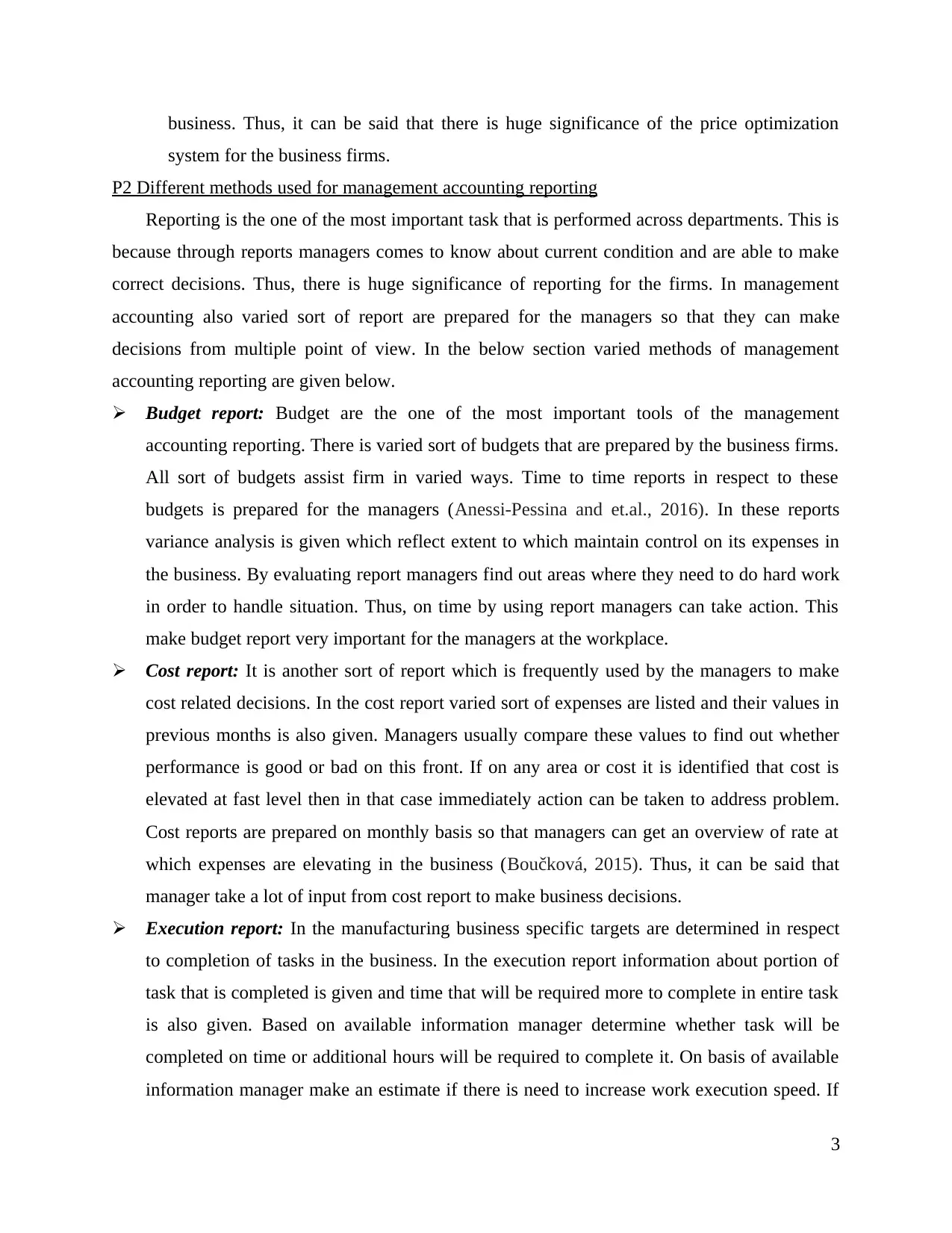
business. Thus, it can be said that there is huge significance of the price optimization
system for the business firms.
P2 Different methods used for management accounting reporting
Reporting is the one of the most important task that is performed across departments. This is
because through reports managers comes to know about current condition and are able to make
correct decisions. Thus, there is huge significance of reporting for the firms. In management
accounting also varied sort of report are prepared for the managers so that they can make
decisions from multiple point of view. In the below section varied methods of management
accounting reporting are given below.
Budget report: Budget are the one of the most important tools of the management
accounting reporting. There is varied sort of budgets that are prepared by the business firms.
All sort of budgets assist firm in varied ways. Time to time reports in respect to these
budgets is prepared for the managers (Anessi-Pessina and et.al., 2016). In these reports
variance analysis is given which reflect extent to which maintain control on its expenses in
the business. By evaluating report managers find out areas where they need to do hard work
in order to handle situation. Thus, on time by using report managers can take action. This
make budget report very important for the managers at the workplace.
Cost report: It is another sort of report which is frequently used by the managers to make
cost related decisions. In the cost report varied sort of expenses are listed and their values in
previous months is also given. Managers usually compare these values to find out whether
performance is good or bad on this front. If on any area or cost it is identified that cost is
elevated at fast level then in that case immediately action can be taken to address problem.
Cost reports are prepared on monthly basis so that managers can get an overview of rate at
which expenses are elevating in the business (Boučková, 2015). Thus, it can be said that
manager take a lot of input from cost report to make business decisions.
Execution report: In the manufacturing business specific targets are determined in respect
to completion of tasks in the business. In the execution report information about portion of
task that is completed is given and time that will be required more to complete in entire task
is also given. Based on available information manager determine whether task will be
completed on time or additional hours will be required to complete it. On basis of available
information manager make an estimate if there is need to increase work execution speed. If
3
system for the business firms.
P2 Different methods used for management accounting reporting
Reporting is the one of the most important task that is performed across departments. This is
because through reports managers comes to know about current condition and are able to make
correct decisions. Thus, there is huge significance of reporting for the firms. In management
accounting also varied sort of report are prepared for the managers so that they can make
decisions from multiple point of view. In the below section varied methods of management
accounting reporting are given below.
Budget report: Budget are the one of the most important tools of the management
accounting reporting. There is varied sort of budgets that are prepared by the business firms.
All sort of budgets assist firm in varied ways. Time to time reports in respect to these
budgets is prepared for the managers (Anessi-Pessina and et.al., 2016). In these reports
variance analysis is given which reflect extent to which maintain control on its expenses in
the business. By evaluating report managers find out areas where they need to do hard work
in order to handle situation. Thus, on time by using report managers can take action. This
make budget report very important for the managers at the workplace.
Cost report: It is another sort of report which is frequently used by the managers to make
cost related decisions. In the cost report varied sort of expenses are listed and their values in
previous months is also given. Managers usually compare these values to find out whether
performance is good or bad on this front. If on any area or cost it is identified that cost is
elevated at fast level then in that case immediately action can be taken to address problem.
Cost reports are prepared on monthly basis so that managers can get an overview of rate at
which expenses are elevating in the business (Boučková, 2015). Thus, it can be said that
manager take a lot of input from cost report to make business decisions.
Execution report: In the manufacturing business specific targets are determined in respect
to completion of tasks in the business. In the execution report information about portion of
task that is completed is given and time that will be required more to complete in entire task
is also given. Based on available information manager determine whether task will be
completed on time or additional hours will be required to complete it. On basis of available
information manager make an estimate if there is need to increase work execution speed. If
3
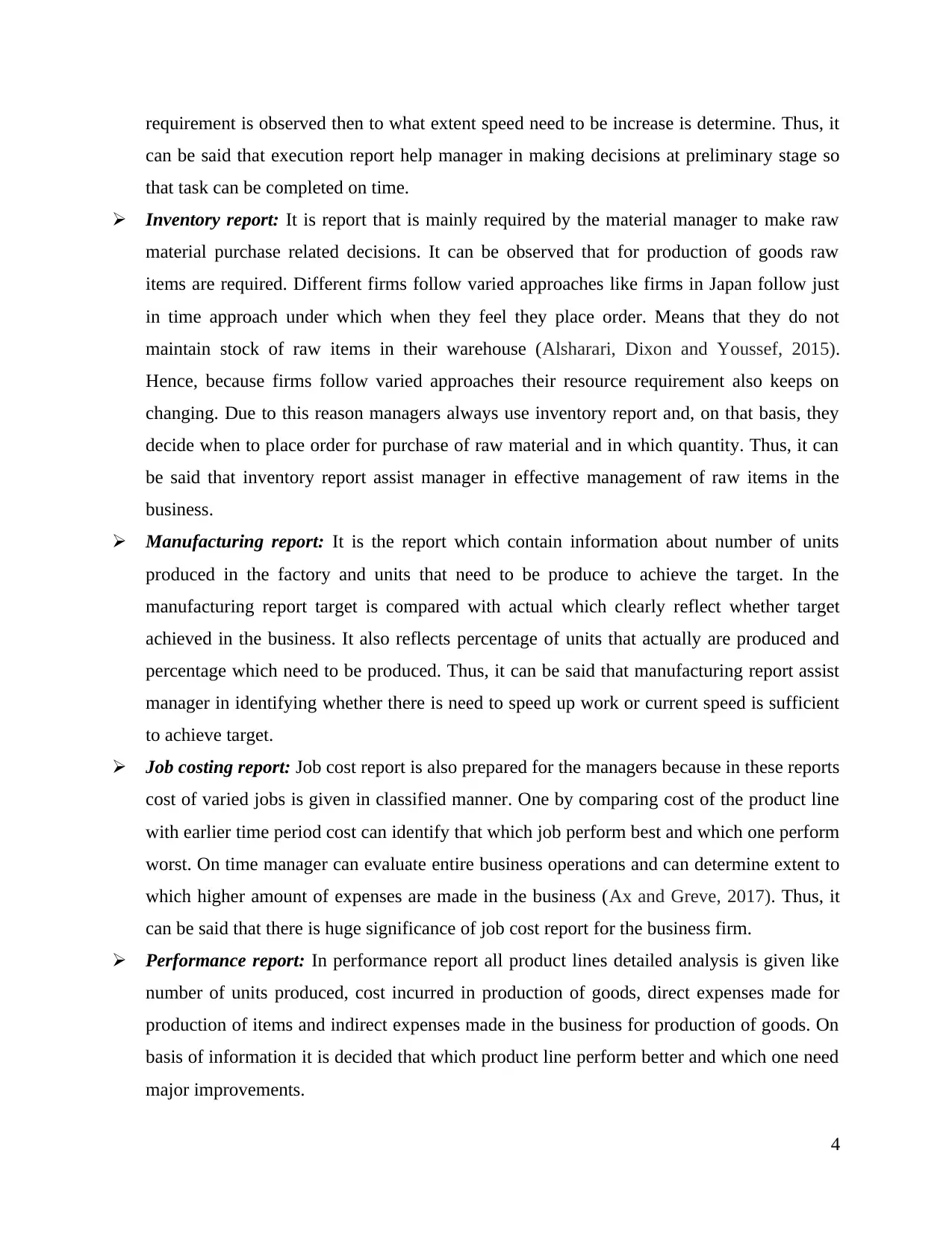
requirement is observed then to what extent speed need to be increase is determine. Thus, it
can be said that execution report help manager in making decisions at preliminary stage so
that task can be completed on time.
Inventory report: It is report that is mainly required by the material manager to make raw
material purchase related decisions. It can be observed that for production of goods raw
items are required. Different firms follow varied approaches like firms in Japan follow just
in time approach under which when they feel they place order. Means that they do not
maintain stock of raw items in their warehouse (Alsharari, Dixon and Youssef, 2015).
Hence, because firms follow varied approaches their resource requirement also keeps on
changing. Due to this reason managers always use inventory report and, on that basis, they
decide when to place order for purchase of raw material and in which quantity. Thus, it can
be said that inventory report assist manager in effective management of raw items in the
business.
Manufacturing report: It is the report which contain information about number of units
produced in the factory and units that need to be produce to achieve the target. In the
manufacturing report target is compared with actual which clearly reflect whether target
achieved in the business. It also reflects percentage of units that actually are produced and
percentage which need to be produced. Thus, it can be said that manufacturing report assist
manager in identifying whether there is need to speed up work or current speed is sufficient
to achieve target.
Job costing report: Job cost report is also prepared for the managers because in these reports
cost of varied jobs is given in classified manner. One by comparing cost of the product line
with earlier time period cost can identify that which job perform best and which one perform
worst. On time manager can evaluate entire business operations and can determine extent to
which higher amount of expenses are made in the business (Ax and Greve, 2017). Thus, it
can be said that there is huge significance of job cost report for the business firm.
Performance report: In performance report all product lines detailed analysis is given like
number of units produced, cost incurred in production of goods, direct expenses made for
production of items and indirect expenses made in the business for production of goods. On
basis of information it is decided that which product line perform better and which one need
major improvements.
4
can be said that execution report help manager in making decisions at preliminary stage so
that task can be completed on time.
Inventory report: It is report that is mainly required by the material manager to make raw
material purchase related decisions. It can be observed that for production of goods raw
items are required. Different firms follow varied approaches like firms in Japan follow just
in time approach under which when they feel they place order. Means that they do not
maintain stock of raw items in their warehouse (Alsharari, Dixon and Youssef, 2015).
Hence, because firms follow varied approaches their resource requirement also keeps on
changing. Due to this reason managers always use inventory report and, on that basis, they
decide when to place order for purchase of raw material and in which quantity. Thus, it can
be said that inventory report assist manager in effective management of raw items in the
business.
Manufacturing report: It is the report which contain information about number of units
produced in the factory and units that need to be produce to achieve the target. In the
manufacturing report target is compared with actual which clearly reflect whether target
achieved in the business. It also reflects percentage of units that actually are produced and
percentage which need to be produced. Thus, it can be said that manufacturing report assist
manager in identifying whether there is need to speed up work or current speed is sufficient
to achieve target.
Job costing report: Job cost report is also prepared for the managers because in these reports
cost of varied jobs is given in classified manner. One by comparing cost of the product line
with earlier time period cost can identify that which job perform best and which one perform
worst. On time manager can evaluate entire business operations and can determine extent to
which higher amount of expenses are made in the business (Ax and Greve, 2017). Thus, it
can be said that there is huge significance of job cost report for the business firm.
Performance report: In performance report all product lines detailed analysis is given like
number of units produced, cost incurred in production of goods, direct expenses made for
production of items and indirect expenses made in the business for production of goods. On
basis of information it is decided that which product line perform better and which one need
major improvements.
4
⊘ This is a preview!⊘
Do you want full access?
Subscribe today to unlock all pages.

Trusted by 1+ million students worldwide
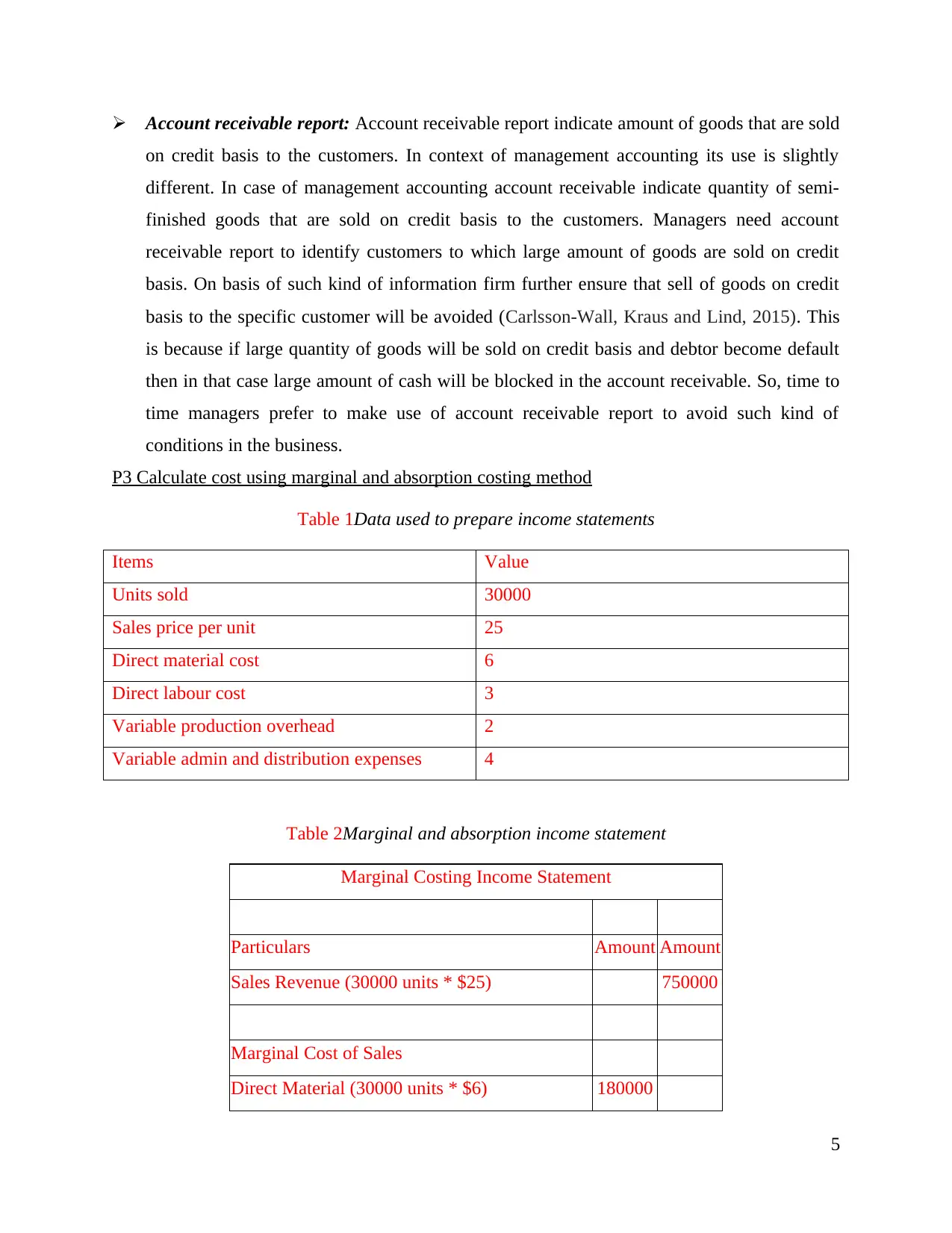
Account receivable report: Account receivable report indicate amount of goods that are sold
on credit basis to the customers. In context of management accounting its use is slightly
different. In case of management accounting account receivable indicate quantity of semi-
finished goods that are sold on credit basis to the customers. Managers need account
receivable report to identify customers to which large amount of goods are sold on credit
basis. On basis of such kind of information firm further ensure that sell of goods on credit
basis to the specific customer will be avoided (Carlsson-Wall, Kraus and Lind, 2015). This
is because if large quantity of goods will be sold on credit basis and debtor become default
then in that case large amount of cash will be blocked in the account receivable. So, time to
time managers prefer to make use of account receivable report to avoid such kind of
conditions in the business.
P3 Calculate cost using marginal and absorption costing method
Table 1Data used to prepare income statements
Items Value
Units sold 30000
Sales price per unit 25
Direct material cost 6
Direct labour cost 3
Variable production overhead 2
Variable admin and distribution expenses 4
Table 2Marginal and absorption income statement
Marginal Costing Income Statement
Particulars Amount Amount
Sales Revenue (30000 units * $25) 750000
Marginal Cost of Sales
Direct Material (30000 units * $6) 180000
5
on credit basis to the customers. In context of management accounting its use is slightly
different. In case of management accounting account receivable indicate quantity of semi-
finished goods that are sold on credit basis to the customers. Managers need account
receivable report to identify customers to which large amount of goods are sold on credit
basis. On basis of such kind of information firm further ensure that sell of goods on credit
basis to the specific customer will be avoided (Carlsson-Wall, Kraus and Lind, 2015). This
is because if large quantity of goods will be sold on credit basis and debtor become default
then in that case large amount of cash will be blocked in the account receivable. So, time to
time managers prefer to make use of account receivable report to avoid such kind of
conditions in the business.
P3 Calculate cost using marginal and absorption costing method
Table 1Data used to prepare income statements
Items Value
Units sold 30000
Sales price per unit 25
Direct material cost 6
Direct labour cost 3
Variable production overhead 2
Variable admin and distribution expenses 4
Table 2Marginal and absorption income statement
Marginal Costing Income Statement
Particulars Amount Amount
Sales Revenue (30000 units * $25) 750000
Marginal Cost of Sales
Direct Material (30000 units * $6) 180000
5
Paraphrase This Document
Need a fresh take? Get an instant paraphrase of this document with our AI Paraphraser
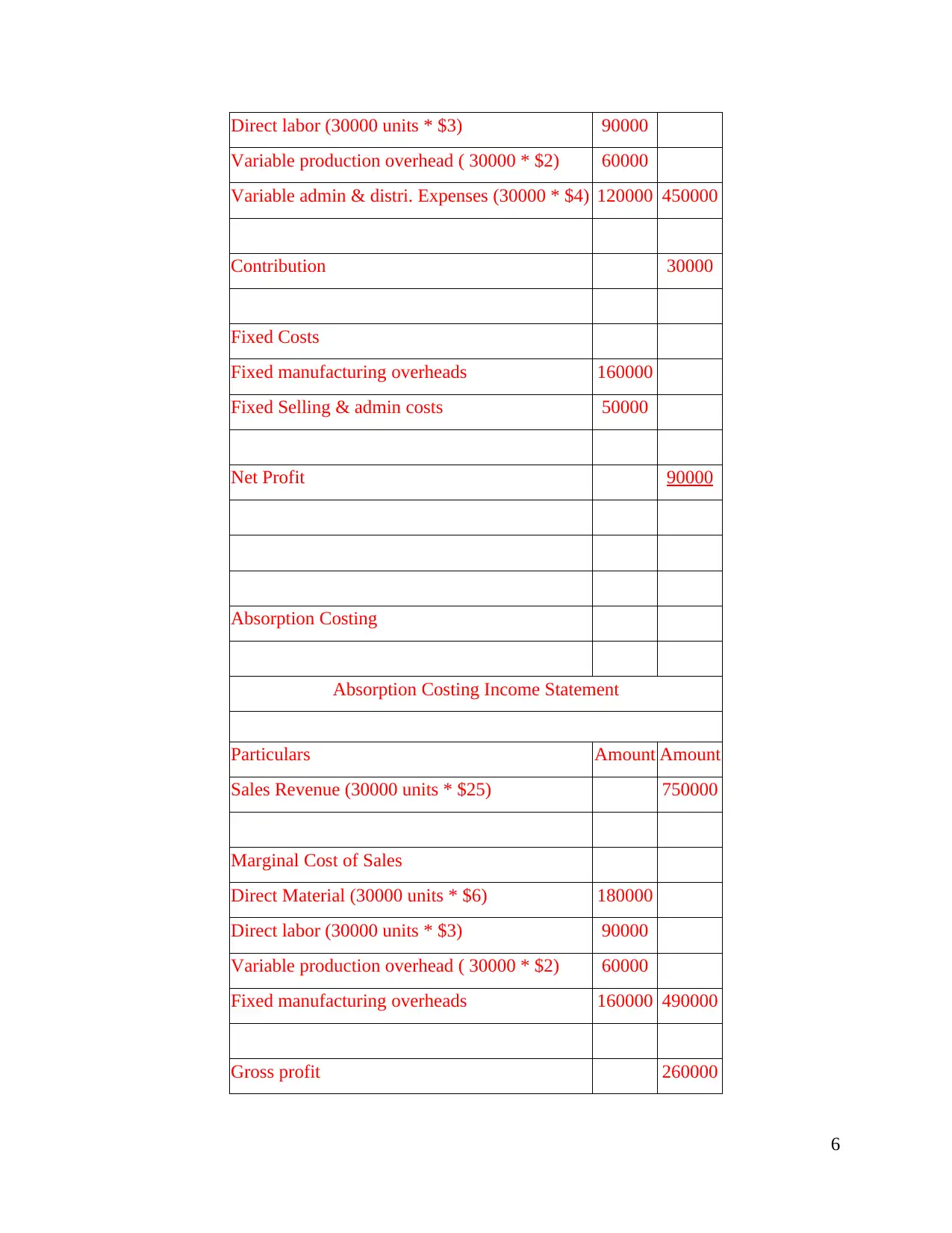
Direct labor (30000 units * $3) 90000
Variable production overhead ( 30000 * $2) 60000
Variable admin & distri. Expenses (30000 * $4) 120000 450000
Contribution 30000
Fixed Costs
Fixed manufacturing overheads 160000
Fixed Selling & admin costs 50000
Net Profit 90000
Absorption Costing
Absorption Costing Income Statement
Particulars Amount Amount
Sales Revenue (30000 units * $25) 750000
Marginal Cost of Sales
Direct Material (30000 units * $6) 180000
Direct labor (30000 units * $3) 90000
Variable production overhead ( 30000 * $2) 60000
Fixed manufacturing overheads 160000 490000
Gross profit 260000
6
Variable production overhead ( 30000 * $2) 60000
Variable admin & distri. Expenses (30000 * $4) 120000 450000
Contribution 30000
Fixed Costs
Fixed manufacturing overheads 160000
Fixed Selling & admin costs 50000
Net Profit 90000
Absorption Costing
Absorption Costing Income Statement
Particulars Amount Amount
Sales Revenue (30000 units * $25) 750000
Marginal Cost of Sales
Direct Material (30000 units * $6) 180000
Direct labor (30000 units * $3) 90000
Variable production overhead ( 30000 * $2) 60000
Fixed manufacturing overheads 160000 490000
Gross profit 260000
6
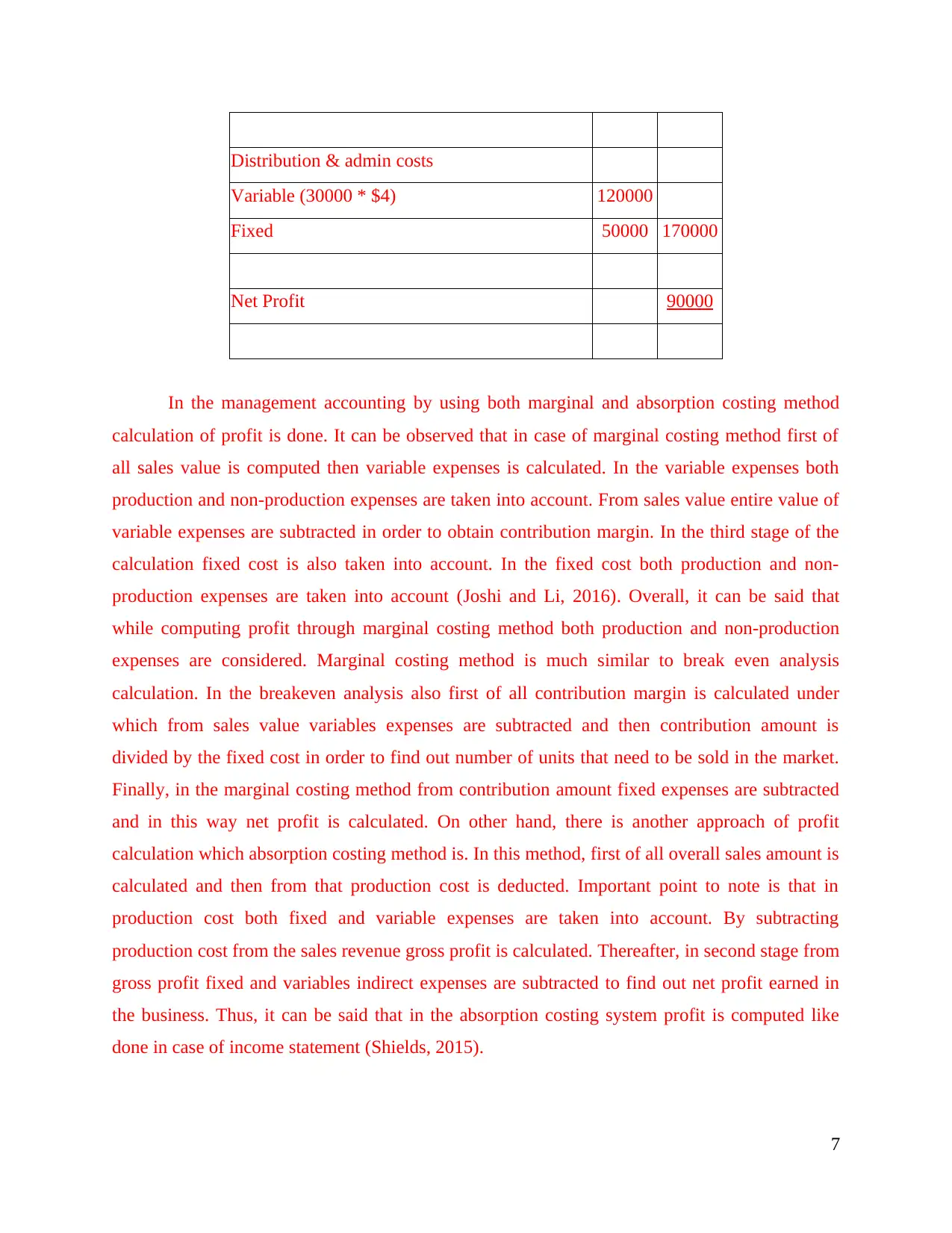
Distribution & admin costs
Variable (30000 * $4) 120000
Fixed 50000 170000
Net Profit 90000
In the management accounting by using both marginal and absorption costing method
calculation of profit is done. It can be observed that in case of marginal costing method first of
all sales value is computed then variable expenses is calculated. In the variable expenses both
production and non-production expenses are taken into account. From sales value entire value of
variable expenses are subtracted in order to obtain contribution margin. In the third stage of the
calculation fixed cost is also taken into account. In the fixed cost both production and non-
production expenses are taken into account (Joshi and Li, 2016). Overall, it can be said that
while computing profit through marginal costing method both production and non-production
expenses are considered. Marginal costing method is much similar to break even analysis
calculation. In the breakeven analysis also first of all contribution margin is calculated under
which from sales value variables expenses are subtracted and then contribution amount is
divided by the fixed cost in order to find out number of units that need to be sold in the market.
Finally, in the marginal costing method from contribution amount fixed expenses are subtracted
and in this way net profit is calculated. On other hand, there is another approach of profit
calculation which absorption costing method is. In this method, first of all overall sales amount is
calculated and then from that production cost is deducted. Important point to note is that in
production cost both fixed and variable expenses are taken into account. By subtracting
production cost from the sales revenue gross profit is calculated. Thereafter, in second stage from
gross profit fixed and variables indirect expenses are subtracted to find out net profit earned in
the business. Thus, it can be said that in the absorption costing system profit is computed like
done in case of income statement (Shields, 2015).
7
Variable (30000 * $4) 120000
Fixed 50000 170000
Net Profit 90000
In the management accounting by using both marginal and absorption costing method
calculation of profit is done. It can be observed that in case of marginal costing method first of
all sales value is computed then variable expenses is calculated. In the variable expenses both
production and non-production expenses are taken into account. From sales value entire value of
variable expenses are subtracted in order to obtain contribution margin. In the third stage of the
calculation fixed cost is also taken into account. In the fixed cost both production and non-
production expenses are taken into account (Joshi and Li, 2016). Overall, it can be said that
while computing profit through marginal costing method both production and non-production
expenses are considered. Marginal costing method is much similar to break even analysis
calculation. In the breakeven analysis also first of all contribution margin is calculated under
which from sales value variables expenses are subtracted and then contribution amount is
divided by the fixed cost in order to find out number of units that need to be sold in the market.
Finally, in the marginal costing method from contribution amount fixed expenses are subtracted
and in this way net profit is calculated. On other hand, there is another approach of profit
calculation which absorption costing method is. In this method, first of all overall sales amount is
calculated and then from that production cost is deducted. Important point to note is that in
production cost both fixed and variable expenses are taken into account. By subtracting
production cost from the sales revenue gross profit is calculated. Thereafter, in second stage from
gross profit fixed and variables indirect expenses are subtracted to find out net profit earned in
the business. Thus, it can be said that in the absorption costing system profit is computed like
done in case of income statement (Shields, 2015).
7
⊘ This is a preview!⊘
Do you want full access?
Subscribe today to unlock all pages.

Trusted by 1+ million students worldwide
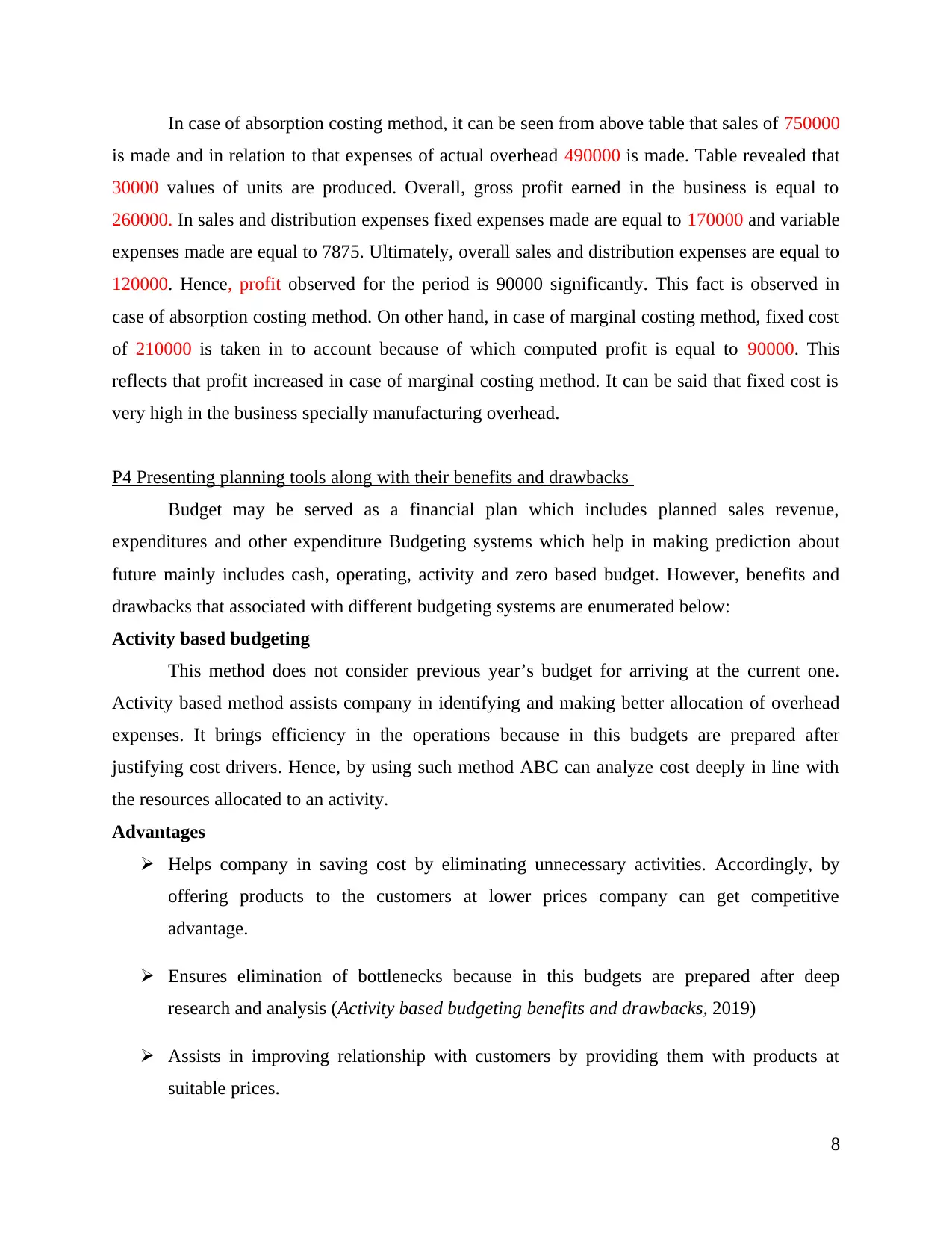
In case of absorption costing method, it can be seen from above table that sales of 750000
is made and in relation to that expenses of actual overhead 490000 is made. Table revealed that
30000 values of units are produced. Overall, gross profit earned in the business is equal to
260000. In sales and distribution expenses fixed expenses made are equal to 170000 and variable
expenses made are equal to 7875. Ultimately, overall sales and distribution expenses are equal to
120000. Hence, profit observed for the period is 90000 significantly. This fact is observed in
case of absorption costing method. On other hand, in case of marginal costing method, fixed cost
of 210000 is taken in to account because of which computed profit is equal to 90000. This
reflects that profit increased in case of marginal costing method. It can be said that fixed cost is
very high in the business specially manufacturing overhead.
P4 Presenting planning tools along with their benefits and drawbacks
Budget may be served as a financial plan which includes planned sales revenue,
expenditures and other expenditure Budgeting systems which help in making prediction about
future mainly includes cash, operating, activity and zero based budget. However, benefits and
drawbacks that associated with different budgeting systems are enumerated below:
Activity based budgeting
This method does not consider previous year’s budget for arriving at the current one.
Activity based method assists company in identifying and making better allocation of overhead
expenses. It brings efficiency in the operations because in this budgets are prepared after
justifying cost drivers. Hence, by using such method ABC can analyze cost deeply in line with
the resources allocated to an activity.
Advantages
Helps company in saving cost by eliminating unnecessary activities. Accordingly, by
offering products to the customers at lower prices company can get competitive
advantage.
Ensures elimination of bottlenecks because in this budgets are prepared after deep
research and analysis (Activity based budgeting benefits and drawbacks, 2019)
Assists in improving relationship with customers by providing them with products at
suitable prices.
8
is made and in relation to that expenses of actual overhead 490000 is made. Table revealed that
30000 values of units are produced. Overall, gross profit earned in the business is equal to
260000. In sales and distribution expenses fixed expenses made are equal to 170000 and variable
expenses made are equal to 7875. Ultimately, overall sales and distribution expenses are equal to
120000. Hence, profit observed for the period is 90000 significantly. This fact is observed in
case of absorption costing method. On other hand, in case of marginal costing method, fixed cost
of 210000 is taken in to account because of which computed profit is equal to 90000. This
reflects that profit increased in case of marginal costing method. It can be said that fixed cost is
very high in the business specially manufacturing overhead.
P4 Presenting planning tools along with their benefits and drawbacks
Budget may be served as a financial plan which includes planned sales revenue,
expenditures and other expenditure Budgeting systems which help in making prediction about
future mainly includes cash, operating, activity and zero based budget. However, benefits and
drawbacks that associated with different budgeting systems are enumerated below:
Activity based budgeting
This method does not consider previous year’s budget for arriving at the current one.
Activity based method assists company in identifying and making better allocation of overhead
expenses. It brings efficiency in the operations because in this budgets are prepared after
justifying cost drivers. Hence, by using such method ABC can analyze cost deeply in line with
the resources allocated to an activity.
Advantages
Helps company in saving cost by eliminating unnecessary activities. Accordingly, by
offering products to the customers at lower prices company can get competitive
advantage.
Ensures elimination of bottlenecks because in this budgets are prepared after deep
research and analysis (Activity based budgeting benefits and drawbacks, 2019)
Assists in improving relationship with customers by providing them with products at
suitable prices.
8
Paraphrase This Document
Need a fresh take? Get an instant paraphrase of this document with our AI Paraphraser
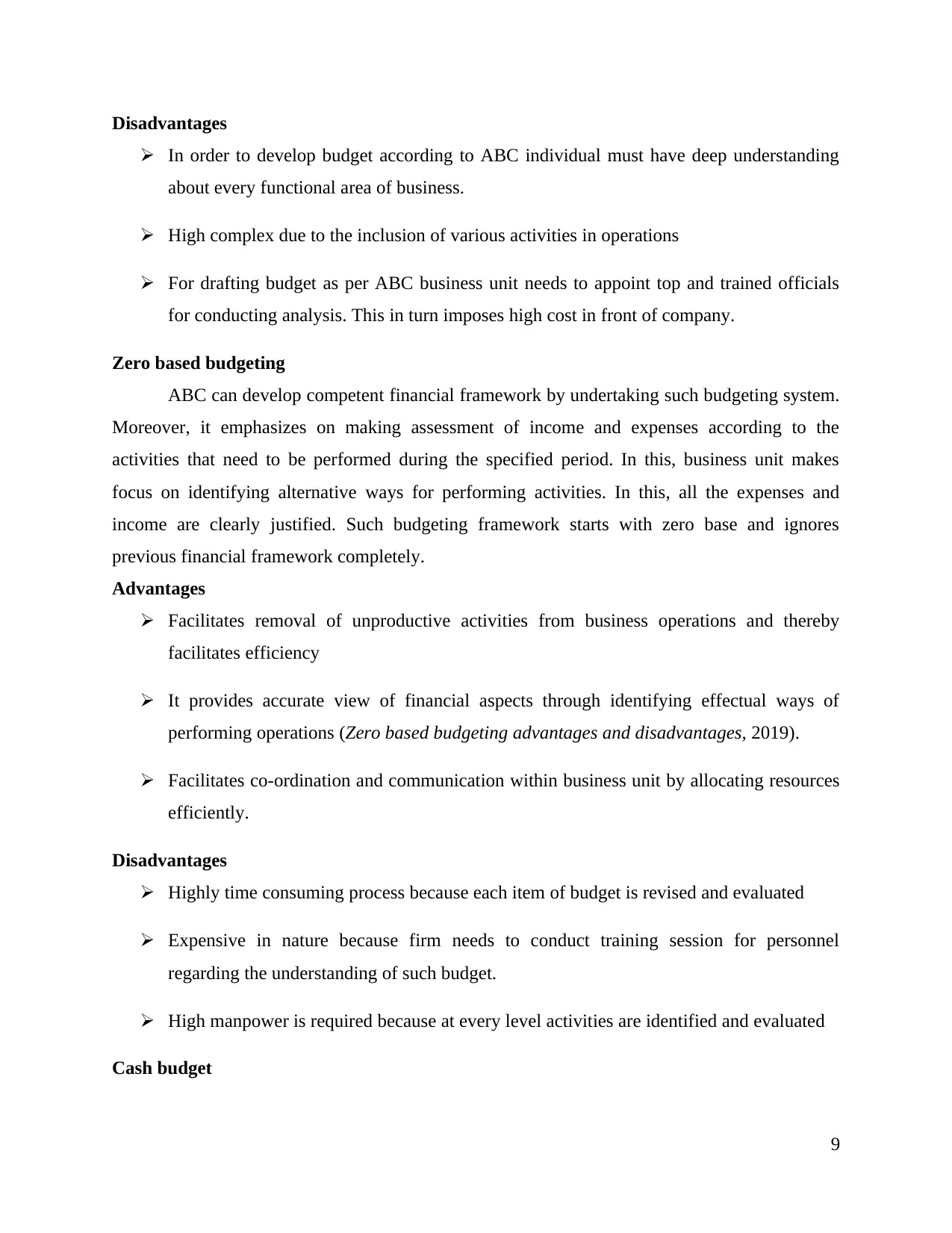
Disadvantages
In order to develop budget according to ABC individual must have deep understanding
about every functional area of business.
High complex due to the inclusion of various activities in operations
For drafting budget as per ABC business unit needs to appoint top and trained officials
for conducting analysis. This in turn imposes high cost in front of company.
Zero based budgeting
ABC can develop competent financial framework by undertaking such budgeting system.
Moreover, it emphasizes on making assessment of income and expenses according to the
activities that need to be performed during the specified period. In this, business unit makes
focus on identifying alternative ways for performing activities. In this, all the expenses and
income are clearly justified. Such budgeting framework starts with zero base and ignores
previous financial framework completely.
Advantages
Facilitates removal of unproductive activities from business operations and thereby
facilitates efficiency
It provides accurate view of financial aspects through identifying effectual ways of
performing operations (Zero based budgeting advantages and disadvantages, 2019).
Facilitates co-ordination and communication within business unit by allocating resources
efficiently.
Disadvantages
Highly time consuming process because each item of budget is revised and evaluated
Expensive in nature because firm needs to conduct training session for personnel
regarding the understanding of such budget.
High manpower is required because at every level activities are identified and evaluated
Cash budget
9
In order to develop budget according to ABC individual must have deep understanding
about every functional area of business.
High complex due to the inclusion of various activities in operations
For drafting budget as per ABC business unit needs to appoint top and trained officials
for conducting analysis. This in turn imposes high cost in front of company.
Zero based budgeting
ABC can develop competent financial framework by undertaking such budgeting system.
Moreover, it emphasizes on making assessment of income and expenses according to the
activities that need to be performed during the specified period. In this, business unit makes
focus on identifying alternative ways for performing activities. In this, all the expenses and
income are clearly justified. Such budgeting framework starts with zero base and ignores
previous financial framework completely.
Advantages
Facilitates removal of unproductive activities from business operations and thereby
facilitates efficiency
It provides accurate view of financial aspects through identifying effectual ways of
performing operations (Zero based budgeting advantages and disadvantages, 2019).
Facilitates co-ordination and communication within business unit by allocating resources
efficiently.
Disadvantages
Highly time consuming process because each item of budget is revised and evaluated
Expensive in nature because firm needs to conduct training session for personnel
regarding the understanding of such budget.
High manpower is required because at every level activities are identified and evaluated
Cash budget
9

This budgeting framework contains both cash inflows and outflows associated wit
business activities pertaining to the specific time.
Advantages
Helps in assessing whether cash balance is sufficient for fulfilling obligations or not.
Gives clear indication to the company in relation to allocating resources in the productive
activities.
It provides standards which can be used by ABC for analyzing variances. In other words,
by doing comparison of actual performance in against to the standards business unit can
identify areas where improvements are needed (What Are the Benefits of a Cash
Budget?.2019)
Disadvantages
It is based on estimation rather than reality
Lack of flexibility limits its significance
Capital budgeting: This in turn recognized as the most effectual tools which ABC can
undertake for planning purpose. Moreover, tools of capital budgeting such as NPV, IRR, ARR,
payback etc provides high level of assistance in evaluating the viability of proposed investments
in monetary terms. In other words, by applying such tools manager of the firm can take
appropriate decision regarding the approval or rejection of investment plan. Moreover, it clearly
entails whether business unit will get enough returns after the specific time period or not.
For example: Business unit has two options for investment with different cash flows
Year
Cash inflow
(Project A) in
£
PV factor
@ 10%
Discounted
cash flows
(Project A) in £
Cash
inflow
(Project B)
in £
Discounted
cash flows
(Project B) in £
1 50000 0.909 45455 48000 43636
2 58000 0.826 47934 52000 42975
3 52500 0.751 39444 46000 34560
4 64000 0.683 43713 56000 38249
5 71000 0.621 44085 69000 42844
10
business activities pertaining to the specific time.
Advantages
Helps in assessing whether cash balance is sufficient for fulfilling obligations or not.
Gives clear indication to the company in relation to allocating resources in the productive
activities.
It provides standards which can be used by ABC for analyzing variances. In other words,
by doing comparison of actual performance in against to the standards business unit can
identify areas where improvements are needed (What Are the Benefits of a Cash
Budget?.2019)
Disadvantages
It is based on estimation rather than reality
Lack of flexibility limits its significance
Capital budgeting: This in turn recognized as the most effectual tools which ABC can
undertake for planning purpose. Moreover, tools of capital budgeting such as NPV, IRR, ARR,
payback etc provides high level of assistance in evaluating the viability of proposed investments
in monetary terms. In other words, by applying such tools manager of the firm can take
appropriate decision regarding the approval or rejection of investment plan. Moreover, it clearly
entails whether business unit will get enough returns after the specific time period or not.
For example: Business unit has two options for investment with different cash flows
Year
Cash inflow
(Project A) in
£
PV factor
@ 10%
Discounted
cash flows
(Project A) in £
Cash
inflow
(Project B)
in £
Discounted
cash flows
(Project B) in £
1 50000 0.909 45455 48000 43636
2 58000 0.826 47934 52000 42975
3 52500 0.751 39444 46000 34560
4 64000 0.683 43713 56000 38249
5 71000 0.621 44085 69000 42844
10
⊘ This is a preview!⊘
Do you want full access?
Subscribe today to unlock all pages.

Trusted by 1+ million students worldwide
1 out of 18
Related Documents
Your All-in-One AI-Powered Toolkit for Academic Success.
+13062052269
info@desklib.com
Available 24*7 on WhatsApp / Email
![[object Object]](/_next/static/media/star-bottom.7253800d.svg)
Unlock your academic potential
Copyright © 2020–2025 A2Z Services. All Rights Reserved. Developed and managed by ZUCOL.





